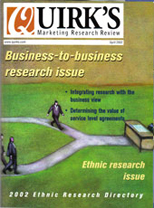Editor's note: Jim Loretta is president of Loretta Marketing Group, a Miami research firm.
The terrorist attacks that occurred on September 11, 2001 were seen and felt by all segments of the American society. The Hispanic community was no exception. Latinos on both sides of the border were as deeply affected as any other demographic population in the United States. Many Hispanics lost loved ones in both World Trade Center towers. The Windows of the World restaurant atop of WTC 1, for example, employed many Hispanics.
Like other Americans, Hispanics were left with a strong sense of fear and insecurity. These fears have caused adverse consequences in researching the Hispanic market.
Many Hispanics in the U.S. have become cautious and tentative. However, their fears were compounded with the ever-present "migra" problem. Because the INS (Immigration and Naturalization Service), commonly known as "la migra" among Hispanics, has increased its presence in cities with heavy Hispanic populations, a telephone call from an unknown person has caused added suspicions. Consequently, telephone recruiting of respondents for Hispanic focus groups has become tougher than usual. Even before 9/11 many Hispanics did not answer the telephone unless it was a family member or a friend. After the attacks, recruiting for focus groups by telephone became a real challenge for many people who study the Hispanic market.
The following are helpful suggestions in increasing respondent cooperation in focus groups that have helped many of us who work in the Hispanic research market:
1. Increase co-op fees to respondents. If the going rate has been $50, you may consider $65 in order to improve respondent participation.
2. Face-to-face recruiting, if possible, is still the preferred way to get Hispanics to a focus group. Parks, strip malls, community centers and churches where Hispanics congregate are ideal places to find respondents.
3. Hire recruiters who have good Hispanic accents appropriate to the local market (Mexicans in Los Angeles, Puerto Ricans in New York, Cubans in Miami).
4. Mail out more than the normal follow-up confirmation letters with toll-free call back numbers for validation purposes. Put the name of a responsible contact person in the letter whom the respondents can call if they have any questions. This personalizes the letter and adds legitimacy to the effort.
5. Emphasize in the letters that they are going to a Hispanic-friendly facility that has bilingual help and free baby-sitting services with goodies (i.e., toys, snacks) for the kids.
6. Recruit more respondents than normal in order to have a successful show rate. (For example, if it is normal to recruit 13 people to seat eight to 10 respondents, you may have to recruit 15 people.)
7. To ease respondent fears of being separated from loved ones, you may consider doing couples groups, which consist of five married couples who come and voice their opinions on the household. The show rate among couples groups is higher and the sessions many times yields richer data. (In this case, babysitting would be essential.)
8. Allow plenty of time to get enough confirmed respondents to attend the group session. If two weeks was the standard time before, you may consider adding another week to provide enough time.
Respectful and accommodating
The mindset that companies need to consider when it comes to researching the Hispanic marketplace in troubling times is the Hispanic family. The "familia" is the safe haven where Hispanics go when the going gets tough. Researchers always need to keep that uppermost in their minds when studying the Latino market. Being respectful, open, and accommodating to the Hispanic family when recruiting for focus groups demonstrates to a Hispanic person that care and concern are important to you. Companies that incorporate this attitude into their recruiting efforts will have minimal problems in achieving successful show rates in these uncertain times.
